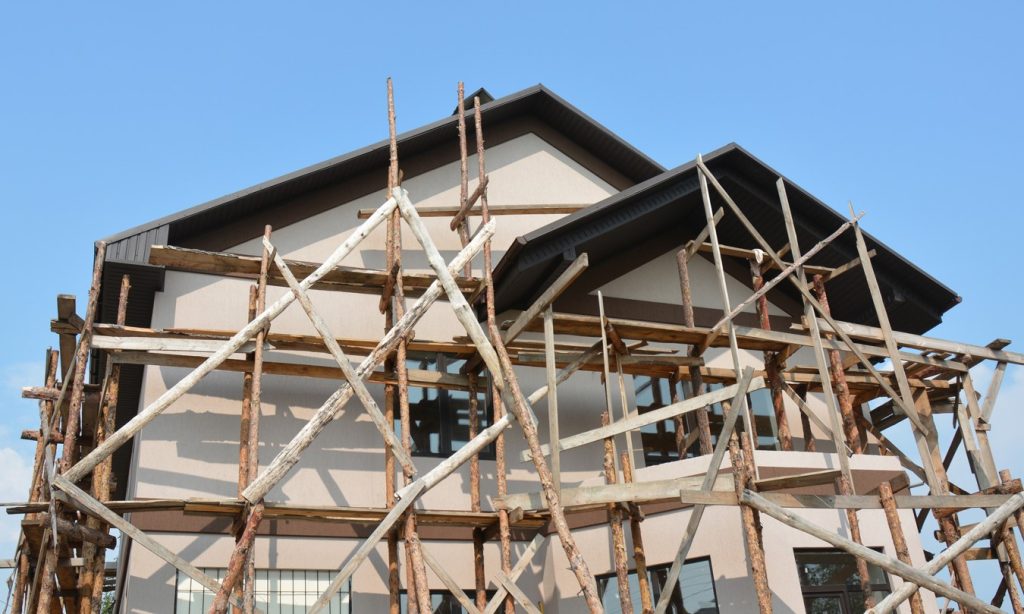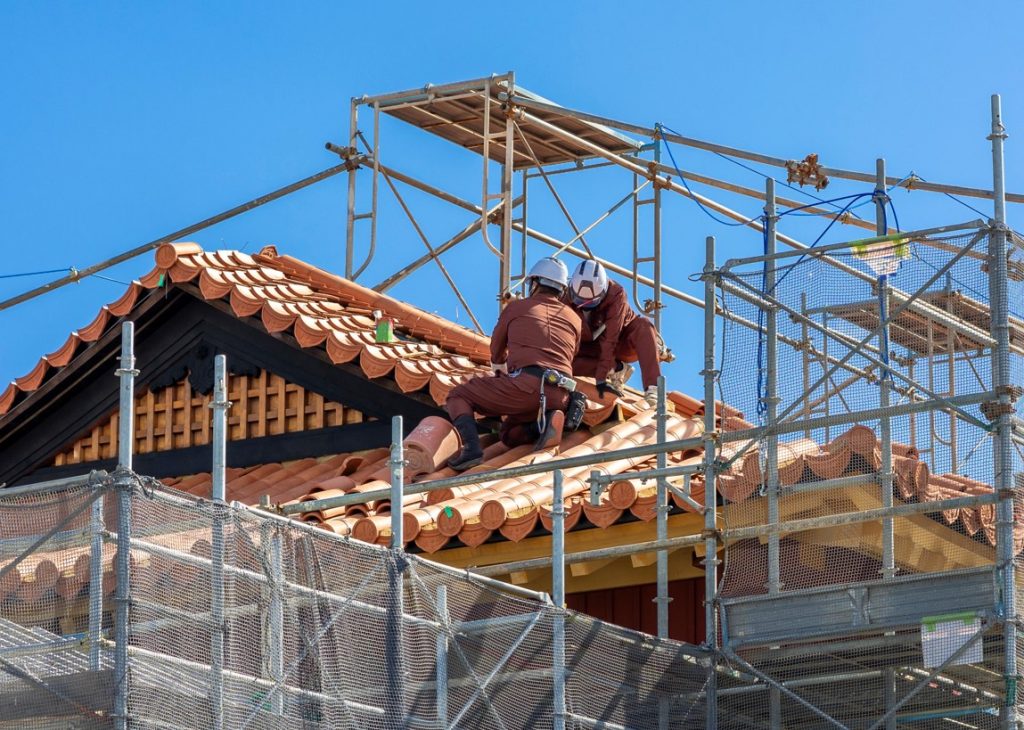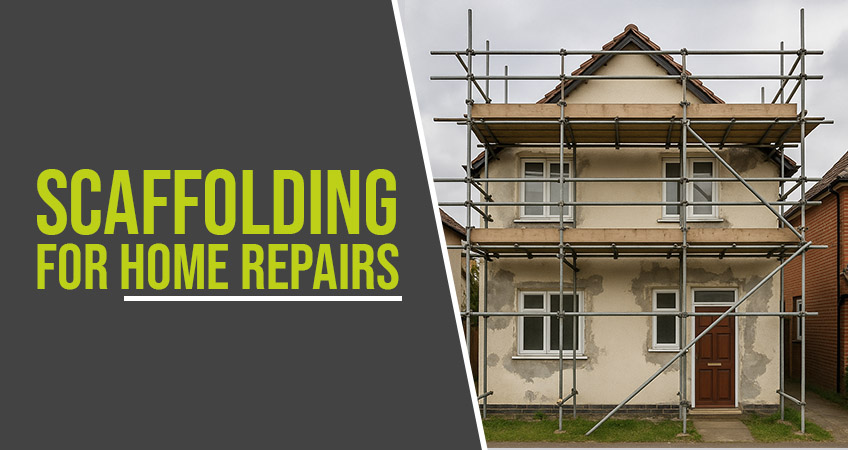Picture Dave from down the street, balanced precariously on a wobbly ladder with a paintbrush in one hand and his mobile phone in the other, trying to touch up his guttering whilst simultaneously ordering pizza for dinner. Fast-forward two hours, and Dave’s in A&E explaining to a very unimpressed nurse how he managed to get tangled in Christmas lights in July.
We’ve all been there—or at least know someone who has. The age-old question haunts every homeowner: “Do I really need proper scaffolding for home repairs, or can I just make do with what’s in the shed?” The answer might surprise you, save you money, and quite possibly prevent you from becoming the neighbourhood cautionary tale.
This article will help you understand when scaffolding for home repairs is absolutely essential, when you might get away without it, and how to make that decision without ending up as an internet meme. By the end, you’ll know exactly when to call in the scaffolding experts and when your trusty stepladder will suffice.
What exactly is scaffolding and why does it matter?

Scaffolding is essentially a temporary structure designed to support workers and materials during construction, maintenance, or repair work. Think of it as a sturdy, reliable platform that doesn’t wobble when you sneeze or threaten to collapse when you lean slightly to the left.
Unlike ladders, which require you to perform acrobatic feats worthy of Cirque du Soleil, scaffolding provides a stable, spacious work area. You can actually move around, use both hands, and—revolutionary concept—breathe normally whilst working. Professional scaffolding systems are engineered to support significant weight and withstand weather conditions that would send your garden ladder flying into next door’s greenhouse.
The importance of proper scaffolding becomes crystal clear when you consider that falls from height account for a significant portion of DIY-related injuries. A scaffolding tower provides not just stability but also safety barriers, preventing those heart-stopping moments when you realise you’ve painted yourself into a corner—literally.
When scaffolding becomes non-negotiable

Some home repairs simply cannot be completed safely without proper scaffolding. These are the jobs where attempting to “make do” isn’t just foolish—it’s downright dangerous.
Roof repairs and maintenance
Any work involving your roof demands scaffolding. Whether you’re replacing tiles, fixing leaks, or clearing blocked gutters, the combination of height, angle, and unpredictable weather makes ladders wholly inadequate. Roof work requires you to move around, carry materials, and often work for extended periods—all impossible when you’re clinging to a ladder like a terrified koala.
Chimney repairs fall into this category too. Chimneys are typically the highest point of your home, often requiring work on multiple sides. A scaffolding tower provides 360-degree access and the stability needed for detailed masonry work.
Multi-storey exterior work
Painting, rendering, or repointing work on two-storey homes and above requires scaffolding. The alternative—constantly moving ladders and stretching to reach every spot—is inefficient, unsafe, and likely to result in patchy work that screams “amateur hour” to anyone walking past.
Heavy material handling
If your repair involves carrying heavy materials up high—think roof tiles, timber, or bags of mortar—you need scaffolding. Attempting to haul significant weight up a ladder is asking for trouble. Professional scaffolding includes secure material lifts and storage areas, making the job manageable rather than a death-defying stunt.
Busting the myths about scaffolding
Let’s address the elephant in the room: the misconceptions that prevent homeowners from using scaffolding when they should.
“It’s too expensive”
Many assume scaffolding rental costs will blow their repair budget out of the water. However, when you factor in the time saved, improved work quality, and reduced injury risk, scaffolding often proves cost-effective. A weekend scaffolding tower rental typically costs less than a single A&E visit, and significantly less than having to redo botched repair work.
“It’s overkill for small jobs”
Even seemingly minor repairs can benefit from proper access equipment. That “quick gutter fix” becomes much quicker when you’re not constantly repositioning a ladder or contorting yourself into impossible positions. Sometimes what seems like overkill is actually the sensible choice.
“I’m only up there for five minutes”
Accidents don’t consult your schedule. Most falls happen during routine, “quick” tasks when people cut corners on safety. Professional scaffolding experts will tell you that many serious injuries occur during jobs that were supposed to take “just five minutes.”
Your scaffolding decision checklist
Before grabbing that ladder or booking scaffolding, run through this practical checklist:
Height considerations:
- Is the work area more than 2.5 metres high?
- Will you need to work at the edge of a roof or elevated surface?
- Are you comfortable working at the required height?
Duration and complexity:
- Will the job take more than an hour to complete?
- Do you need both hands free to work effectively?
- Will you need to move materials up to the work area?
Weather and conditions:
- Is windy weather forecast during your planned work time?
- Are the surfaces wet, slippery, or unstable?
- Will you be working in challenging lighting conditions?
Personal factors:
- Do you have any balance or mobility issues?
- Are you confident working at height?
- Do you have experience with the specific repair task?
If you’ve answered “yes” to several of these questions, scaffolding isn’t just advisable—it’s essential.
Making the smart choice for your home
The question isn’t really whether you need scaffolding for home repairs—it’s whether you value your safety, the quality of your work, and your peace of mind. Professional scaffolding transforms precarious, stressful repair jobs into manageable tasks you can complete properly and safely.
Remember Dave from our opening tale? After his ladder incident, he invested in proper scaffolding for his next project. Not only did he complete his exterior painting in half the time, but his neighbours stopped crossing the street when they saw him approaching with tools.
Don’t let false economy or misguided bravado turn your home improvement project into a cautionary tale. When your repair job involves significant height, duration, or complexity, contact B-Mat Scaffolding for a professional scaffold inspection and quote. Your future self—and your family—will thank you for making the smart choice.
Meet the scaffolding experts: B-Mat scaffolding
When you’ve decided that proper scaffolding is the way forward, choosing the right provider makes all the difference. B-Mat Scaffolding specialises in domestic scaffolding solutions, understanding that homeowners need reliable access equipment without the complexity of commercial construction projects.
Our team provides comprehensive scaffold inspection, ensuring your temporary structure meets all safety standards. More importantly, we offer guidance on whether your specific project actually requires scaffolding—because reputable scaffolding experts won’t try to sell you services you don’t need.
B-Mat’s domestic focus means we understand the unique challenges of residential work: tight spaces, neighbouring properties, garden protection, and the need for quick, efficient installation that doesn’t disrupt your daily routine.
Reach out today to learn more about services and get a free quote for your scaffolding project.


